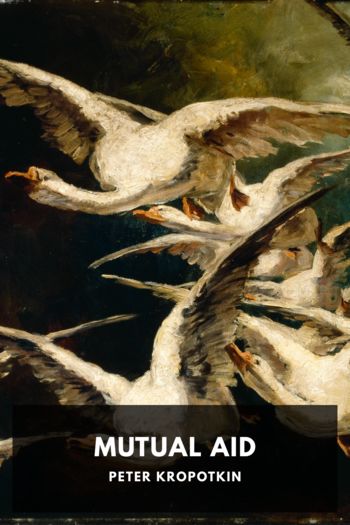Mutual Aid, Peter Kropotkin [fiction novels to read .txt] 📗

- Author: Peter Kropotkin
Book online «Mutual Aid, Peter Kropotkin [fiction novels to read .txt] 📗». Author Peter Kropotkin
As to the idea and the form of such an organization, its elements were already indicated from the savage period downwards. We know indeed that in the clans of all savages there are separate secret organizations of warriors, of witches, of young men, etc.—craft mysteries, in which knowledge concerning hunting or warfare is transmitted; in a word, “clubs,” as Miklukho-Maclay described them. These “mysteries” were, in all probability, the prototypes of the future guilds.322
With regard to the above-mentioned work by E. Martin-Saint-Léon, let me add that it contains very valuable information concerning the organization of the trades in Paris—as it appears from the Livre des métiers of Boileau—and a good summary of information relative to the Communes of different parts of France, with all bibliographical indications. It must, however, be remembered that Paris was a “Royal city” (like Moscow, or Westminster), and that consequently the free medieval-city institutions have never attained there the development which they have attained in free cities. Far from representing “the picture of a typical corporation,” the corporations of Paris, “born and developed under the direct tutorship of royalty,” for this very same cause (which the author considers a cause of superiority, while it was a cause of inferiority—he himself fully shows in different parts of his work how the interference of the imperial power in Rome, and of the royal power in France, destroyed and paralyzed the life of the craft-guilds) could never attain the wonderful growth and influence upon all the life of the city which they did attain in Northeastern France, at Lyons, Montpellier, Nimes, etc., or in the free cities of Italy, Flanders, Germany, and so on.
XI The Market and the Medieval CityIn a work on the medieval city (Markt und Stadt in ihrem rechtlichen Verhältnis, Leipzig, 1896), Rietschel has developed the idea that the origin of the German medieval communes must be sought in the market. The local market, placed under the protection of a bishop, a monastery or a prince, gathered round it a population of tradesmen and artisans, but no agricultural population. The sections into which the towns were usually divided, radiating from the marketplace and peopled each with artisans of special trades, are a proof of that: they formed usually the Old Town, while the New Town used to be a rural village belonging to the prince or the king. The two were governed by different laws.
It is certainly true that the market has played an important part in the early development of all medieval cities, contributing to increase the wealth of the citizens, and giving them ideas of independence; but, as has been remarked by Carl Hegel—the well-known author of a very good general work on German medieval cities (Die Entstehung des deutschen Städtewesens, Leipzig, 1898), the town-law is not a market-law, and Hegel’s conclusion is (in further support to the views taken in this book) that the medieval city has had a double origin. There were in it “two populations placed by the side of each other: one rural, and the other purely urban;” the rural population, which formerly lived under the organization of the Almende, or village community, was incorporated in the city.
With regard to the Merchant Guilds, the work of Herman van den Linden (Les Gildes marchandes dans les Pays-Bas au Moyen Age, Gand, 1896, in Recueil de travaux publiés par la Faculté de Philosophie et Lettres) deserves a special mention. The author follows the gradual development of their political force and the authority which they gradually acquired upon the industrial population, especially on the drapers, and describes the league concluded by the artisans to oppose their growing power. The idea, which is developed in this book, concerning the appearance of the merchant guild at a later period which mostly corresponded to a period of decline of the city liberties, seems thus to find confirmation in H. van den Linden’s researches.
XII Mutual-Aid Arrangements in the Villages of Netherlands at the Present DayThe Report of the Agricultural Commission of Netherlands contains many illustrations relative to this subject, and my friend, M. Cornelissen, was kind enough to pick out for me the corresponding passages from these bulky volumes (Uitkomsten van het Onderzoek naar den Toestand van den Landbouw in Nederland, 2 vols. 1890).
The habit of having one thrashing-machine, which makes the round of many farms, hiring it in turn, is very widely spread, as it is by this time in nearly every other country. But one finds here and there a commune which keeps one thrashing-machine for the community (vol. I, xviii. p. 31).
The farmers who have not the necessary numbers of horses for the plough borrow the horses from their neighbours. The habit of keeping one communal ox, or one communal stallion, is very common.
When the village has to raise the ground (in the low districts) in order to build a communal school, or for one of the peasants in order to build a new house, a bede is usually convoked. The same is done for those farmers who have to move. The bede is altogether a widely-spread custom, and no one, rich or poor, will fail to come with his horse and cart.
The renting in common, by several agricultural labourers, of a meadow, for keeping their cows, is found in several parts of the land; it is also frequent that the farmer, who has plough and horses, ploughs the land for his hired labourers (vol. I, xxii, p. 18, etc.).
As to the farmers’ unions for buying seed, exporting vegetables to England and so





Comments (0)